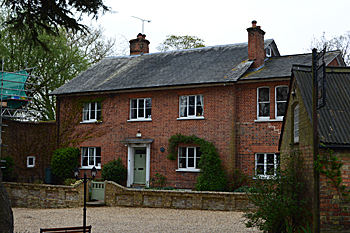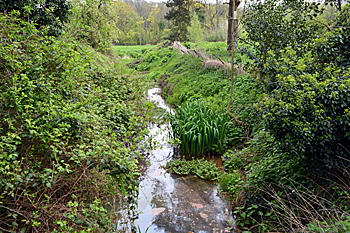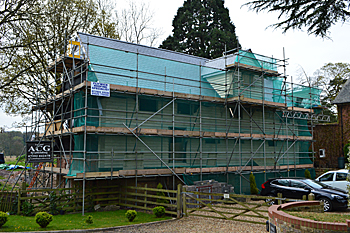Flitwick Mill
![Flitwick Mill [Z1130-50-79]](/CommunityHistories/Flitwick/Flitwick-Images/Flitwick-Mill-Z1130-50-79350x205.jpg)
Flitwick Mill and mill house about 1900 [ref: Z1130/50/79]
Flitwick has had a number of watermills in different sites and at different dates.It had a watermill at Domesday, which may have been on or near the site of the mill in Greenfield Road or the mill which lay on the stream which marked the northern boundary between Flitwick and Ampthill and is shown on the 1st edition Ordnance Survey map of 1881. The site today lies just west of the sewage works, south of the A505.
The first certain mention of a mill at Greenfield Road, or East End is in 1347 [ref: LL1/13] when Joan, widow of William Lock of Millbrook granted it to John, son of John le Wheler of Flitwick. It is described, in Latin, as an open space [placea] in the curtilage late of Henry Heynes at Eston between a villein’s tenement of David de Flitwick and a tenement of Robert le Ryche, shooting to the leat of David de Flitwick’s mill.
A deed held at The National Archives [ref: CRT100/31] relates to a lease by the Earl of Kent to William Huyns (a similar name to the Henry Heynes of 1347) of his mill at “Eastowne” [East Town] in Flitwick, with house, dam and pightle of pasture as well as a windmill in Ampthill Park for 21 years from 1518 at a rent of £4 per annum. In 1542 “Eston Myll” was held by Robert Spede [ref: CRT100/25].
In 1700 the three watermills under one roof (that is a mill with three pairs of grinding stones) with a messuage (house), wheat mill and two grist mills called East Towne or East End Mills with land amounting to two acres was conveyed for £120 by Mary Cheyne of Ivinghoe Aston [Buckinghamshire], widow to William Geary of Startuppe End, Marsworth [Buckinghamshire], yeoman. The previous owner had been a miller with the marvellous name of Odin Turner [ref: X234/1-2]. In 1705 Geary conveyed the mill to Mathew Woodward of Flitton, yeoman for £90 [ref: X234/3-4]. Woodward made his will in 1731 and devised his real estate to trustees to settle his debts then to be divided equally between his grandson Matthew Manfield and daughter Rebecca Kilby [ref: X234/8]. The will was proved in January 1733.
In the event the mil ldid not pass to Woodward’s daughter and grandson because in 1744 Woodward’s trustees conveyed mill, house, three roods of pasture and a house at East End to Ampthill draper Thomas Langhorne for £351/3/1 [ref: X234/13-14]. Langhorne made his will in that same year [ref: X234/16] and devised his real estate to trustees for the benefit of his widow, then to their children. He died and his will was proved in 1749.
In 1766 Langhorne’s children and trustees conveyed the mill and mill house, land an house in East End to the miller Richard Goodman, late of Great Brickhill [Buckinghamshire] for £340 [ref: X234/18-19]. The Goodman family would be millers in Flitwick well into the 20th century. Richard Goodman in his will of 1744, proved in 1776, devised his property to his wife Martha, then, after her death, to his son John of Salford, miller [ref: X234/21]. When John made his will in 1802 he had moved to Husborne Crawley and called himself a gentleman. He left the mill in Flitwick to his brother Thomas, of Hulcote, and his kinsman Richard Goodman junior of Flitwick, who ran the mill, in trust [ref: X234/22]. He died in that same year.

The mill house April 2017
In 1823 John Goodman’s various beneficiaries conveyed the Flitwick mill to its miller Richard Goodman for £700 [ref: X234/25] who seems to have built the mill house the following year. In 1861 mill proprietor Richard Goodman consented to a new road [ref: P59/22/3-4].
The Rating and Valuation Act 1925 specified that every building and piece of land in the country was to be assessed to determine its rateable value. The valuer visiting the mill and mill house [ref: DV1/C129/49-51] found them still owned and occupied by a Richard Goodman.
The mill contained a water wheel, shafting of nine feet length and one foot diameter driven by an eight horsepower motor and two pairs of four foot diameter grinding stones (“only one used”). The mill had three floors. There was a large room downstairs used for storing corn, maize etc. On the first floor was a large room used for the same purpose as the ground floor “the stones are on this floor”. The second floor contained thirteen bins. There was also a lean-to brick and slate office.
The valuer commented: “Not enough water in Summer causes floods in winter. Only uses one pair stones. Used as much for storage as for a mill”. He also noted: “Mill works on an average ten hours a day, grinds corn, barley, maize, oats and beans. Averages four bushels an hour. Mr Goodman says he is more of a corn merchant than a miller”.
The mill house comprised a drawing room, dining room, two kitchens, dairy, apple room and bathroom (“added on”). Seven bedrooms lay upstairs as well as a WC. Outside was a lean-to glasshouse measuring 15 feet 6 inches by 7 feet 6 inches. There were also two brick and slate earth closets, a dog kennel, a brick and slate chaise house, a brick and slate harness room, a weather-boarded and tiled coal barn, a weather-boarded and tiled two-bay open cart hovel with a loft over, and brick and tiled house used for keeping petrol and artificial manure and a brick and slated stable with four stalls.
The valuer noted that the house was built in 1824. He commented “No electric light etc. rather hidden away”.

Flitwick mill stream April 2017
In January 1961 the former Ministry of Works listed the mill and mill house as Grade II, of special interest (updating the listing in 2005); sadly none of the buildings dates back to 1347. As noted above, the house is 19th century, built of red brick with a slate roofand adjoins the north-west corner of the mill, thus forming an L-shape between them. There is a later 19th century addition to the right-hand side with a shallower pitch to the roof.
The mill itself is dated late 18th or early 19th century and so is, perhaps, the work of Richard Goodman. It was extended twice in the later 19th century “probably between 1882 and 1901”. It has a brick ground floor, with bricks of various types and colours representing different periods of building, extension and repair. The upper floors are timber-framed and weather-boarded, the latter replaced between 1988 and 1993. The three storeys all sit beneath slate roofing.
The listing comments: “The mill is a rare surviving example of a complete milling process. While the building is not architecturally of a piece, since it has been extended and reclad, it demonstrates the continuing process of expansion and development of the 19th century mill. It retains its complete water system, with clay- lined pond, waterways, sluices and hatches, the latter repaired as recently as 1982, when the mill was still working. Its archaeological context is intact. Attached is a mid-19th century mill house, with adjacent barn, wagon sheds and former stables. Although the latter are considerably altered, they help to illustrate how the site worked. The mill ceased trading in 1987 and was surveyed and recorded by Kenneth Major in 1988 and 1993. It is well documented and recorded, with good surviving paperwork and tools”. The mill was undergoing another restoration at the time of writing [2017].

Flitwick Mill under reconstruction, April 2017
List of sources at Bedfordshire Archives:
- LL1/13: Grant, 1347
- X234/1-30: Deeds relating to messuage at East End, Flitwick, close of pasture and three watermills, 1700-1824
- P59/22/3-4: Consents of Richard Goodman the proprietor of Flitwick Water Mill to an intended road to run from the road to the mills to the road from Flitwick to Westoning
- X291/200/3: Photograph of Flitwick Water Mill, 19th century
- DV1/C129: Valuation book, 1927
- Z851/9/5: Photograph of Flitwick: The Water Mill, East End, 1970
- BP64/18/2: Photograph of Flitwick Mill Waterwheel, 1970s
- Z50/50/43: Photograph of Flitwick Mill Waterwheel, 1970s
- Z1749/2/4/2: Black and white photograph of the south side of Flitwick Mill showing the water wheel, 2020